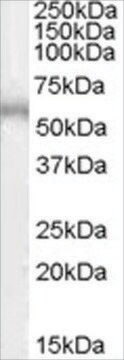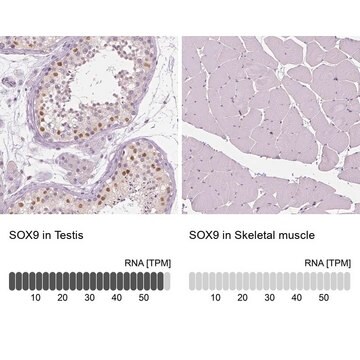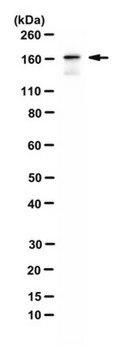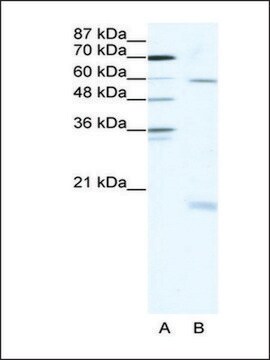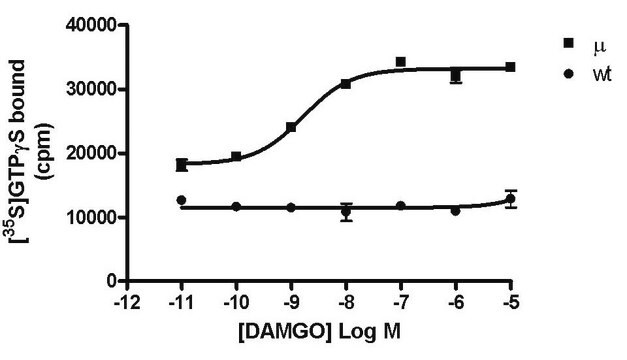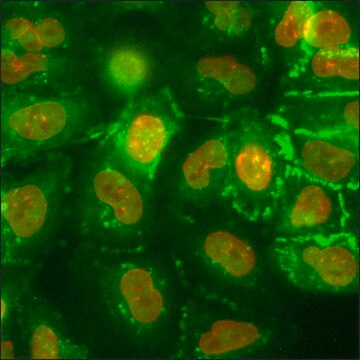AB9680
Anti-GABA A Receptor β 1 Antibody
Chemicon®, from rabbit
Sign Into View Organizational & Contract Pricing
All Photos(1)
About This Item
UNSPSC Code:
12352203
eCl@ss:
32160702
NACRES:
NA.41
clone:
polyclonal
application:
WB
species reactivity:
human, rat, mouse
technique(s):
western blot: suitable
citations:
4
Recommended Products
biological source
rabbit
Quality Level
antibody form
affinity purified immunoglobulin
antibody product type
primary antibodies
clone
polyclonal
purified by
affinity chromatography
species reactivity
human, rat, mouse
manufacturer/tradename
Chemicon®
technique(s)
western blot: suitable
NCBI accession no.
UniProt accession no.
shipped in
dry ice
target post-translational modification
unmodified
Gene Information
human ... GABRB1(2560)
Specificity
GABAA Receptor beta 1 subunit. The antibody recognizes a protein of ~55 kDa corresponding to GABAA Receptor beta 1 subunit in lysates from rat cerebellum and cortex.
Immunogen
Fusion protein from the Cytosolic loop of rat the GABAA Receptor beta 1 subunit.
Application
Research Category
Neuroscience
Neuroscience
Research Sub Category
Neurotransmitters & Receptors
Neurotransmitters & Receptors
This Anti-GABA A Receptor β 1 Antibody is validated for use in WB for the detection of GABA A Receptor β 1.
Western blot: 1:1,000.
Optimal working dilutions must be determined by the end user.
Optimal working dilutions must be determined by the end user.
Linkage
Replaces: AB5451
Physical form
Affinity purified immunoglobulin. Liquid in 10 mM HEPES (pH 7.5), 150 mM NaCl, 100 μg/mL BSA and 50% glycerol.
Storage and Stability
Maintain at -20°C in undiluted for up to 6 months after date of receipt. Avoid repeated freeze/thaw cycles. Do not store in a self defrosting freezer.
Legal Information
CHEMICON is a registered trademark of Merck KGaA, Darmstadt, Germany
Disclaimer
Unless otherwise stated in our catalog or other company documentation accompanying the product(s), our products are intended for research use only and are not to be used for any other purpose, which includes but is not limited to, unauthorized commercial uses, in vitro diagnostic uses, ex vivo or in vivo therapeutic uses or any type of consumption or application to humans or animals.
Not finding the right product?
Try our Product Selector Tool.
Storage Class
10 - Combustible liquids
wgk_germany
WGK 2
Certificates of Analysis (COA)
Search for Certificates of Analysis (COA) by entering the products Lot/Batch Number. Lot and Batch Numbers can be found on a product’s label following the words ‘Lot’ or ‘Batch’.
Already Own This Product?
Find documentation for the products that you have recently purchased in the Document Library.
R W Olsen et al.
FASEB journal : official publication of the Federation of American Societies for Experimental Biology, 4(5), 1469-1480 (1990-03-01)
The major type of receptor for the inhibitory neurotransmitter gamma-aminobutyric acid (GABA), called the GABAA receptor, is a member of a gene superfamily of ligand-gated ion channels. This receptor is a hetero-oligomeric protein composed of several distinct polypeptide types (alpha
Affinity of various benzodiazepine site ligands in mice with a point mutation in the GABAA receptor gamma2-subunit.
Ogris W, et al.
Biochemical Pharmacology, 68, 1621-1629 (2004)
Angelika Pöltl et al.
Journal of neurochemistry, 87(6), 1444-1455 (2004-01-10)
In cerebellum, 13 different GABA(A) receptor subunits are expressed. The number of different receptor subtypes formed in this tissue, their subunit composition and their quantitative importance so far has not been determined. In the present study, immunodepletion by immunoaffinity chromatography
A K Mehta et al.
Brain research. Molecular brain research, 67(1), 194-199 (1999-04-02)
The anti-alpha1 antibody elicited higher immunoprecipitation (%) values of the [3H]flunitrazepam and [3H]muscimol binding activity in the rat cerebellum vs. cerebral cortex, whereas immunoprecipitation values for [3H]Ro 15-4513 and [3H]zolpidem were comparable in these brain regions. Chronic ethanol administration neither
Alejandra Cabello-Arreola et al.
Genes, 11(3) (2020-03-04)
Suicide is a major public health concern; nevertheless, its neurobiology remains unknown. An area of interest in suicide research is the dorsolateral prefrontal cortex (DLPFC). We aimed to identify altered proteins and potential biological pathways in the DLPFC of individuals
Our team of scientists has experience in all areas of research including Life Science, Material Science, Chemical Synthesis, Chromatography, Analytical and many others.
Contact Technical Service